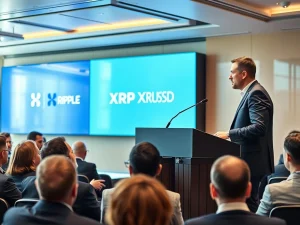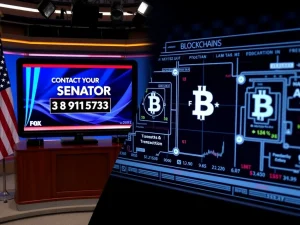Stablecoins Poised for Massive $2 Trillion Surge, Says Ripple CEO

The cryptocurrency market is buzzing with predictions of explosive market growth, particularly within the stablecoin sector. Ripple CEO Brad Garlinghouse recently shared insights suggesting that the stablecoin market, currently valued around $250 billion, could see a tenfold increase in just a few years, potentially reaching $1 to $2 trillion.
Brad Garlinghouse on Profound Stablecoin Growth
Brad Garlinghouse highlighted the significant expansion already seen in the stablecoin market. He noted that Ripple’s own involvement, including the launch of their enterprise-focused stablecoin RLUSD, demonstrates confidence in this growth trajectory. Ripple joined the stablecoin market later, leveraging its experience in institutional payments and regulatory compliance to participate effectively.
Key points from Garlinghouse:
- Stablecoin market cap is currently around $250 billion.
- Prediction: Could reach $1 to $2 trillion in a handful of years.
- Growth has been “profound.”
- Ripple is well-positioned due to institutional background and compliance focus.
Ripple’s Strategic Moves: RLUSD and BNY Mellon
Supporting this outlook, Ripple made a significant announcement regarding its RLUSD stablecoin. BNY Mellon will serve as the custodian for RLUSD, a dollar-pegged asset launched in late 2024. RLUSD recently achieved a notable milestone, reaching a $500 million market capitalization, signaling early traction in the enterprise space.
This move underscores Ripple’s strategy to build bridges between traditional finance and decentralized finance, a key theme Garlinghouse emphasized. Aligning with major financial institutions like BNY Mellon is crucial for achieving this goal.
Expert Views on Stablecoin Market Growth Catalysts
Industry experts echo Garlinghouse’s optimistic forecast. Henrik Andersson, CIO at Apollo Capital, agrees with the $1-2 trillion prediction, observing that various financial entities, from fintechs to banks and social networks, are exploring or launching their own stablecoins. He pointed to Tether’s profitability as evidence of the sector’s potential.
A major factor expected to drive further stablecoin adoption is evolving crypto regulation in the United States. Experts cite the potential impact of the GENIUS Act, which recently passed a Senate vote and is anticipated to become law soon. This legislation could provide a clearer legal framework for stablecoins, potentially classifying them as legal tender and accelerating adoption.
Nick Ruck of LVRG Research commented that a supportive SEC combined with legislation like the GENIUS Act could align the crypto industry for rapid expansion, making the $1-2 trillion stablecoin market goal achievable within a few years.
Ripple’s Push for US Crypto Regulation Compliance
Ripple is actively pursuing full regulatory compliance in the US. The company aims to operate under the same framework as traditional financial institutions. Earlier this month, Ripple applied for a banking license with the US Office of the Comptroller of the Currency (OCC). They have also applied for a Federal Reserve Master Account.
These steps demonstrate Ripple’s commitment to navigating the regulatory landscape and integrating with the existing financial system. Garlinghouse believes building strong connections between traditional finance and DeFi is essential for the future of the industry.
Beyond Stablecoins: XRP’s Recent Performance
While the focus is on stablecoins and crypto regulation, Ripple’s native token, XRP, has also seen positive movement. Following announcements, including RLUSD’s integration with payments platform Transak, XRP’s price increased. The token rallied 7% recently, trading at its highest price in seven weeks.
Summary: The Trillion-Dollar Stablecoin Future
The outlook for stablecoins appears bright, with industry leaders like Brad Garlinghouse predicting substantial market growth to $1-2 trillion. This expansion is fueled by increasing institutional adoption, strategic partnerships like Ripple’s with BNY Mellon, and anticipated positive crypto regulation. As companies like Ripple actively work towards regulatory clarity and building bridges to traditional finance, the foundation for a significantly larger stablecoin market is being laid, promising exciting developments for the broader crypto ecosystem.








